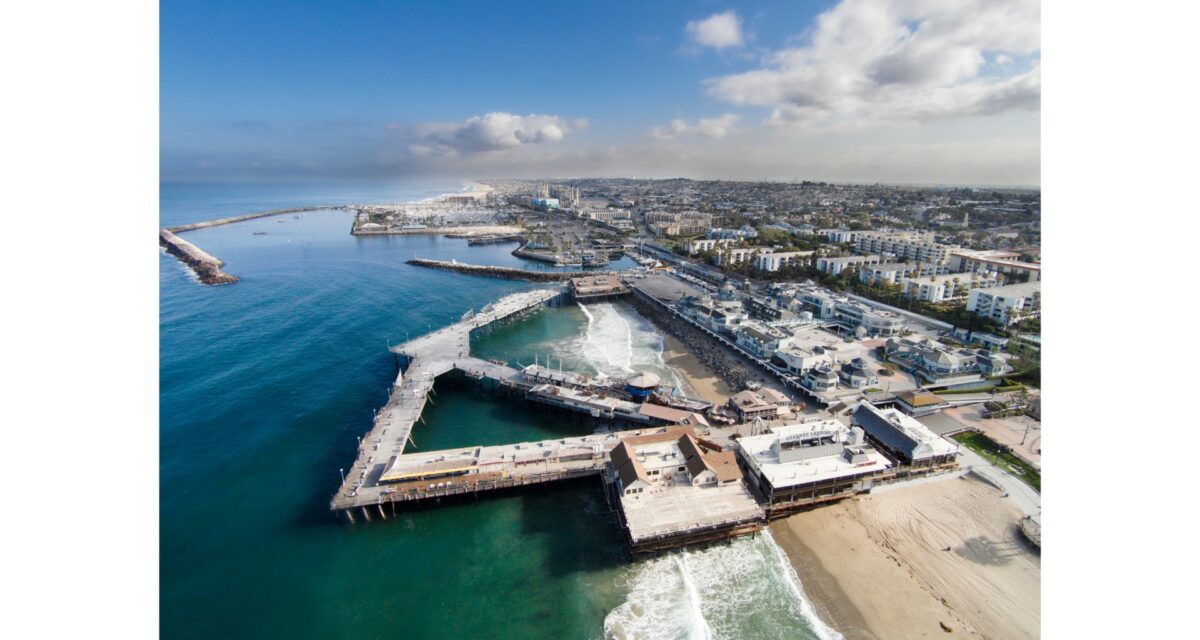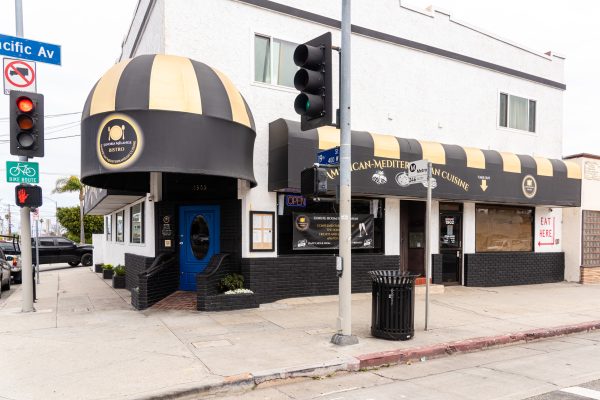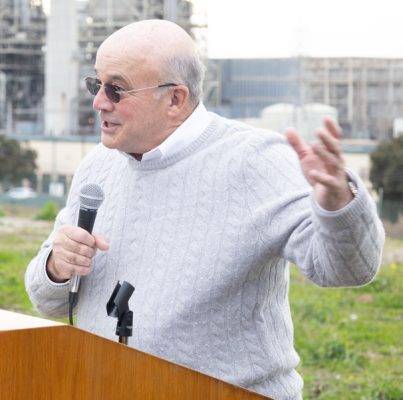
Nearly a month after the passage of Redondo Beach’s harbor-area rezoning Measure C, the future of the Redondo waterfront is cloudier than it’s been in years.
Mayor Bill Brand has a dream for a master-planned waterfront that incorporates both City-controlled leaseholds and the land under the AES power plant site.
CenterCal CEO Fred Bruning still sees possibilities for the citizens of Redondo Beach to receive the waterfront he believes they deserve, despite legal hurdles in the way.
After a failed attempt to rid Redondo Beach of the power plant he has helped to oversee for more than a decade, AES Vice President Eric Pendergraft once still drives down 190th Street, wondering what could’ve been. Now, he wonders who will take the land.
Finally, members of Redondo Beach’s voting public, led by Martin Holmes of Rescue Our Waterfront, banded together to create their own vision of the city’s future at the ballot box, one that includes decidedly smaller-scale development than Bruning’s vision.
But even the best-laid plans, no matter who sets them in motion, can die — particularly when it comes to the Redondo Beach waterfront.
Powering solutions?
News that the City of Redondo Beach and AES had found common ground in wanting to get rid of the long-standing Redondo Generating Station after decades of disagreement flabbergasted longtime onlookers in 2014.
But Eric Pendergraft, an engineer by trade who stumbled into political campaigns and relationships with city officials, was more than ready to make a deal and get his company a fair return in exchange for finally clearing the century-old power plant off of the Redondo Beach waterfront.
Instead, the Measure B “Harbor Village” rezoning plan died at the ballot box in March 2015, with 52.4 percent of voters against it. Pendergraft was stunned. He said, at the time, that AES might look at building a water desalination plant, a battery storage facility, or even certifying a new plant to go on its 50 acres of land.
But in November 2015, the company made an about face, striking a deal with the city to put the land on the real estate market for non-industrial use.
More than a year later, AES is still searching for a buyer, though not for want of attention.
“We launched marketing in the early part of 2016, and got multiple offers in,” Pendergraft said. “But as we were vetting, we realized we didn’t have enough clarity on a number of things on our side.”
Topping that list is the length of time and cost required to demolish the existing plant and remediate the site, which is key assessing the property’s value.
Demolition of the plant itself is a touchy subject. As Pendergraft spoke, a stack of apartment buildings to the north of the plant loomed through the window, over his shoulder. The site’s placement amid active retail and residential housing makes implosion untenable, practically forcing manual dismantling, Pendergraft said. A midpoint cost for complete remediation is estimated to be about $95 million, and would take about three years.
AES also has to factor in the future of the Southern California Edison switchyard and easements SCE has over the property. There’s also the matter of an “alleged wetland” clouding matters, Pendergraft said. As a landmark outside of AES’s gates notes, the site was once the location of Redondo’s Old Salt Lake. Though Pendergraft challenges the assertion, California Coastal Commission staff believes that there may still be underlying seawater at the site.
What all of that means is that AES has seen a range of values for the sale, between $50 million and $250 million.
“[It depends on] who is responsible for remediation, if it’s a sale with the site entitled with current zoning or contingent on future zoning and a public vote, as well as Coastal Commission approval and council approval,” Pendergraft said.
But even if AES were to find a buyer immediately, Pendergraft believes that construction on the site wouldn’t begin until 2024, including remediation. The existing plant must be decommissioned by the end of 2020 to comply with state regulations. Further complicating matters is AES’s contract to produce power, which ends in December 2020.
All of that adds up to a sticky situation for AES, though Pendergraft seems cautiously hopeful. The plant has had suitors at the ready, all planning some form of mixed-use development and seemingly unperturbed by Redondo’s political drama. Measure C may have changed that, though.
“We don’t know yet. We’re in the process of going back to developers and assessing their reaction to the results,” Pendergraft said. “It may change our perspective…it may not. If it significantly diminishes their interest or value, that will probably result in us saying we’re going to hold, and wait for a better overall environment.”
However, Pendergraft also noted that Brand’s election may be a boon to some developers.
“That the most vocal opposition group now has one of their leaders in charge…if you can get him satisfied with the development scenario for the site, the path gets a lot clearer,” Pendergraft said.
The key is finding a solution that is a win to everyone involved, from AES to the developer to the residents.
But given the current climate in Redondo Beach, mixed-use might be a stumbling block.
Publicly-laid plans
On March 30, more than 100 people sat around 10 tables at Samba Brazilian Grill, spinning ideas for what they’d like to see now that Measure C is the law of the land.
Twenty posters, titled with prompts, taped to the walls were eventually filled with sticky notes provided at the tables. One poster asked what people liked about CenterCal’s plan; another asked what they disliked. Two more asked the same questions about the existing waterfront, while a fifth poster asked people to politely send a message to CenterCal.
“That one got a good 30 to 40 messages, all pretty polite, mostly asking CenterCal to ‘work with us to develop something balanced that meets Measure C, or just go away,’” Martin Holmes said.
What Holmes took away from that night was that the community felt ignored by CenterCal.
“There was near-unanimous thinking that the project was too big, too dense and didn’t have enough open space,” Holmes said. “And CenterCal responded to that by making it more big and more dense with less open space.”
The town hall, as Holmes called it, was the first in an expected series, as ROW makes an effort to bring in resident views from all sides.
Holmes estimated that, on average, about 50 responses were attached to the posters, resulting in about 1,000 ideas from the roughly 100 people in attendance.
The biggest issue, he noted, was about harbor-area recreation.
“People valued different concepts with a swimming facility, whether it’s Seaside Lagoon or a wave pool, or something in the middle,” Holmes said. “They wanted a safe, good location for a boat ramp, and they wanted open space to just walk around and enjoy the view.”
Inside the room, ideas hit common themes: there should be parkland, restaurants in all price ranges, retail shops should serve waterfront needs, art and recreation should be considered.
“Some didn’t care about Seaside Lagoon or a boat ramp, and some people liked a movie theater,” Holmes said. “Certainly some ideas are going against the ROW grain, but nevertheless, you’ll find those in our 30 pages of raw notes and see it in the analysis.”
Holmes estimates that it’ll still be a good week or so before he’s analyzed the data, but he thinks there’s still room to work.
“If CenterCal were to come back to the community with something they want, I don’t think the community would fight them…it’s about the substance of what’s created for Redondo Beach,” Holmes said. “But I will say, the one point where people are taking it personally is CenterCal’s rejection of Measure C and their lawsuit against the City.”
Holmes’s goal is for the City Council to listen to the will of the people and send Measure C to the Coastal Commission so they can “do with it what they will.” But he is more than happy to meet with CenterCal and Bruning to discuss the community’s wants going forward.
“I think the community has spoken here, and said they’re willing to work with a CenterCal, but we need a partner here,” Holmes said. “We can’t compromise if there’s not a partner involved.”

Searching for open minds
CenterCal CEO Fred Bruning often keeps a smile, a cheerful tone and a homespun joke at the ready.
That an undercurrent of frustration rode below his takes on the results of the Measure C election shows how unhappy he was with what took place on March 8.
“There was so much misinformation spread, people who said they voted for Measure C because they heard we were putting workforce housing on office buildings, or building the equivalent of five Walmarts,” Bruning said, shaking his head. “A typical Walmart in Southern California is 265,000 square feet — five Walmarts would be 1.3 million.”
At some point, Bruning said, it seems that opposition to his company’s project “lost its polarization on their magnetic compass.”
Bruning can’t help but point out the irony that the very things that Measure C proponents hoped to “save” from CenterCal may be reaching their end anyway. The end of Redondo’s Sportfishing Pier has been closed for structural repairs, and mechanical failures have worried civic leaders that Seaside Lagoon won’t operate in time for the Fourth of July.
But, to ensure that the Waterfront project has a fighting chance following the passage of Measure C, CenterCal has filed a lawsuit with the City of Redondo Beach to challenge the rezoning measure’s legality.
“What we feel is that we’re already vested because of our approvals,” Bruning said. “Measure C itself says it doesn’t apply to any projects that are vested…so if we are, then by their own admission, C doesn’t apply to us.”
The lawsuit, filed in Los Angeles Superior Court and delivered to the City on March 28, argues that Measure C is “illegal, unconstitutional and invalid” under state law, and is seeking the Court prohibit the enforcement of all of Measure C’s provisions.
CenterCal’s belief is that the project has been vested through both the completion of its application with the city, as well as decisions made by Redondo’s Harbor Commission and City Council approving the project and frameworks to advance further.
“Three thousand more people voted ‘Yes’ for Measure G than ‘Yes’ on Measure C,” Bruning said, when asked if he felt a voter mandate shot down the Waterfront plan. “I think if C had been presented in an honest and unbiased way, and people had not done everything from voter intimidation to outright falsehoods, the community would have had a better chance to weigh in.”
The plan now, Bruning said, is to pursue their court petition and permitting with the Coastal Commission, all the while continuing attempts to sway the public to their side. To that end, Bruning hopes that CenterCal’s information center, at the former On The Rocks location near Harbor Drive and Portofino Way, will be able to deter what he considered “fake news” coming from rivals.
“Whether it’s civil engineers, marine engineers, environmental scientists, or people who just understand the science behind what’s going on at the Lagoon,” Bruning said. “We’re going to invite people from organizations on what’s happening in the most successful communities, like walkability and living streets, all things we intend to make part of this project.”
He also hoped that more information about the project might stem the undercurrents of racism he saw in the opposition campaign.
“There were posters they had, showing police helicopters over the project, that it was bringing in ‘those people,’ which infuriates me,” Bruning said, fighting claims that the project wasn’t built for Redondo’s citizens.
“Building something for Redondo has been our goal from day one, but…we want to build something that’s so compelling that people from all over Southern California may want to visit and enjoy the project,” Bruning said. “Hearing that we’re going to bring in gangbangers and five Walmarts and police helicopters panders to the worst attributes of [our society].”
That said, Bruning doesn’t feel the sides are forever split.
“People who work in good faith can get along, but if you don’t wish to, you can never move them,” Bruning said, hoping that they will be able to meet with new members of the City Council, such as Todd Loewenstein. “We’re open to having a discussion with anyone; it’s a lot easier to have them with someone with an open mind, and we hope Todd will have that.”
Building a new Brand
By the time this issue hits the streets, Bill Brand will have been Redondo Beach’s mayor for less than 48 hours. But when it comes to matters of the waterfront, Brand’s an old hand.
His road to activism started with the Heart of the City plan, in 2001. He and his wife at the time were flipping through TV channels when they happened to catch a planning commission hearing on the plan.
“Before that, I was like those people who had their face in the sand,” Brand said. “I didn’t know what was going on and I didn’t care. But once I bought a house, I started to pay much closer attention.”
He watched as person after person got up, voicing their disapproval and was stunned when the Planning Commission, and eventually, the City Council, passed the plan. He was shocked by the density of Heart of the City, maxing out at 3,000 condo units, and amazed that anyone could approve that plan.
That’s when he got involved, gathering signatures, supporting candidates and forming bonds among fellow activists.
Sixteen years, one failed council run and three successful elections later, Brand is now Redondo Beach’s leader.
“People move here for a reason — they get here and they like it,” Brand said. “Then change comes knocking at the door, and they say ‘No, I don’t want you to change anything.’ That’s the message we’re seeing time and time again.”
That, he feels, has spurred community activism and the passage of ballot measures designed to combat overdevelopment.
“That’s been my fundamental policy: We don’t want to become Santa Monica and we don’t want to become Manhattan Beach,” Brand said. “We want to maintain the culture we have.”
The desire to keep the Redondo Beach he’s known is what’s kept him fighting against City, and then AES, during their proposals to build more housing along the Redondo Beach waterfront. It’s also what kept him in the fight against CenterCal’s Waterfront development project.
“Building a giant project, or a bunch of housing, people — young, old, rich, poor — don’t want that,” Brand said. “The more people learned about CenterCal, the more people came to our side; we were surmising that, had this campaign kept going another week, [Measure C] would’ve had 60 percent.”
Now that the CenterCal project hangs in the balance, to be decided by courts and the Coastal Commission, Brand hopes to move forward with setting a master plan for the Redondo Beach waterfront, including the AES power plant.
“AES has always wanted to have their little individual overdevelopment project…I think they’re looking out of their own best interest at every turn in hopes of getting a large development program,” Brand said. “But that’s unrealistic. We’ve got 50 acres on the waterfront; we should be creating a comprehensive integrated plan to benefit everyone.”
Having almost the entirety of the King Harbor waterfront under city control is a boon, but to ignore AES’s 50 acres is “piecemeal overdevelopment,” Brand said.
Pendergraft, however, feel that Brand’s vision is a stretch.
“The ‘master plan’ concept sounds great on the surface, but there’s a lot of complications,” Pendergraft said. “We’re on completely different timelines; the waterfront is ready to be developed now, but at a minimum, our site won’t be ready for any new development until 2024.”
Bruning concurs.
“First of all, the two projects have nothing to do with each other; the Waterfront’s benefits go to the city; they get rent, we take on infrastructure costs,” Bruning said. “AES is a very complicated project that’s going to involve many years of discussion…not to say it’s not going to be a wonderful project at the end of the day.”
What it comes down to, Bruning believes, is a sense of kicking the can down the road in terms of projects.
“I’ve heard people say, ‘What if you put all the parking at AES?’ Parking there would be inconvenient for customers, and they won’t want to come,” Bruning said. “I’ve heard housing, another hotel, a lot of possibilities, but no one has a clue as to what the answer is…none of them have answers.”
Brand isn’t trying to come up with all of the answers. He’s just looking to keep Redondo Beach as he remembers it.
“Some people are trying to turn this into Santa Monica. That tide, I’m trying to stem, but I’m not trying to stem the tide of reasonable economic growth, quality of life or increasing revenues,” Brand said. “I want to accomplish those things without overdevelopment projects like CenterCal, or allowing AES to build hundreds of condos.”









